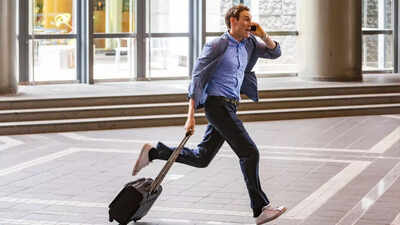Trending
Viral: What is the crazy 'airport theory' trend and know why is it risky
The "airport theory" trend on social media encourages travelers to arrive at airports just minutes before boarding. This practice, popular on TikTok, aims to reduce waiting times but poses significant risks, including missed flights and financial loss. Travel experts advise sticking to traditional guidelines for a smoother experience, recommending early arrivals to avoid unnecessary stress and hassle.
A new social media craze, the "airport theory," is rapidly gaining attention on social media, with travelers taking to the platforms to post their experiences to race through airports and catch their flights at the last possible moment. What the theory tells the passengers to do is surprising!
While this trend tries to reduce the overcrowding at the airports, it also increases the shortcomings involved with air travel.
With millions of views and growing popularity during the busy spring break season, the "airport theory" is thrilling yet controversial, drawing the interest of travelers eager to push the limits and experts warning of potential consequences.
What is the ‘airport theory’?

Experts, including travel specialist Katy Nastro, have talked about the dangers of relying on the "airport theory." She explains that the risks include missing the flight entirely, which could force a person to buy a new ticket if the airline won’t assist in rebooking. This could result in not only financial loss but also unnecessary stress and hassle, especially if the airport is particularly busy.
This theory is going viral on the internet
The "airport theory" has also led to a surge in searches for related terms. Google searches for "airport theory" have hit record levels, and even the TSA (Transportation Security Administration) has joined in to warn travelers against testing out the trend. Apart from this, the number of searches for "I missed my flight, what do I do" has jumped by 70% in the past month, according to Wired, a clear sign of the consequences some travelers are facing as a result of embracing this risky trend.

Following this theory could also lead to financial loss
The financial implications can also be severe. Airlines may charge significant fees for rebooking, and in some cases, there may be limited availability on flights. If a traveler is marked as a “no-show,” their entire itinerary could be cancelled, leading to even greater inconvenience. In addition, last-minute re-bookings and the stress of frantic travelers can create a heavy burden on airport employees, adding to the chaos that already comes with busy travel days.

Instead of embracing the gamble of the "airport theory," travel experts recommend sticking with more traditional advice for smoother and less stressful travel. Experts suggest arriving at the airport at least two hours before a domestic flight and three hours before an international flight, and these buffers are not unpredictable, they allow travelers ample time to get through security, check-in, get any last-minute necessities, and also might easily help to tackle the unforeseen circumstances.
The practicality of the "airport theory" depends heavily on the airport. While smaller regional airports might allow for quicker move-through, the trend becomes nearly impossible at large international hubs, where the large size and multiple checks make such a rush unrealistic.
End of Article
FOLLOW US ON SOCIAL MEDIA
Visual Stories
Tired of too many ads?










